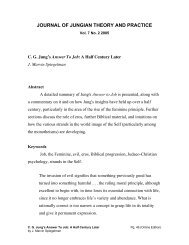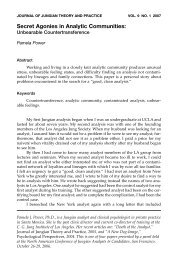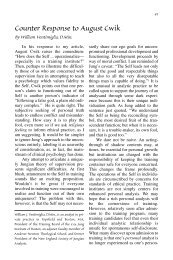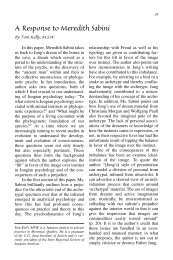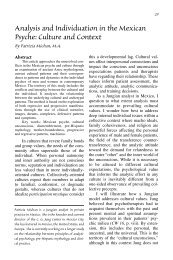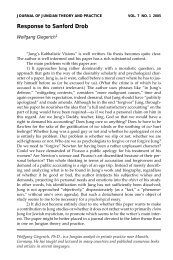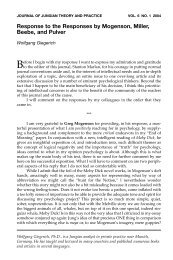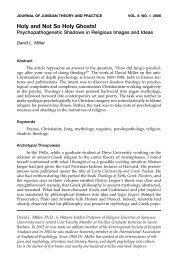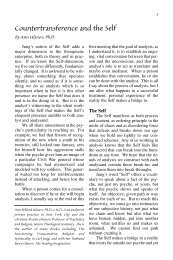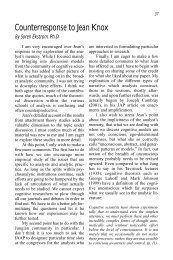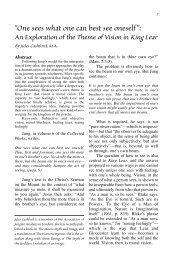The Union of Opposites in the Kabbalah - The new Israeli Jungian ...
The Union of Opposites in the Kabbalah - The new Israeli Jungian ...
The Union of Opposites in the Kabbalah - The new Israeli Jungian ...
You also want an ePaper? Increase the reach of your titles
YUMPU automatically turns print PDFs into web optimized ePapers that Google loves.
JOURNAL OF JUNGIAN THEORY AND PRACTICE VOL. 7 NO. 1 2005<br />
<strong>The</strong> <strong>Union</strong> <strong>of</strong> <strong>Opposites</strong> <strong>in</strong> <strong>the</strong> <strong>Kabbalah</strong><br />
Gustav Dreifuss<br />
Abstract<br />
<strong>The</strong> union <strong>of</strong> opposites <strong>in</strong> <strong>the</strong> <strong>Kabbalah</strong> (<strong>the</strong> Tree <strong>of</strong> Life) and <strong>in</strong> alchemy is<br />
discussed. <strong>The</strong> kabbalistic tree <strong>of</strong> life represents <strong>the</strong> dynamic aspect <strong>of</strong> <strong>the</strong> div<strong>in</strong>e<br />
be<strong>in</strong>g and, psychologically, <strong>of</strong> <strong>the</strong> Self. <strong>The</strong> symbolic, archetypal aspect <strong>of</strong> sexuality<br />
is shown as a mysterium coniunctionis. <strong>The</strong> Song <strong>of</strong> Songs, <strong>the</strong> biblical erotic<br />
poem, is added as an amplification <strong>of</strong> <strong>the</strong> mascul<strong>in</strong>e-fem<strong>in</strong><strong>in</strong>e union.<br />
Keywords<br />
<strong>Kabbalah</strong>, Sephiroth, alchemy, coniunctio.<br />
Whereas Christian culture elaborated <strong>the</strong> idea <strong>of</strong> <strong>the</strong> union <strong>of</strong> opposites with<strong>in</strong><br />
<strong>the</strong> framework <strong>of</strong> alchemy, <strong>the</strong> <strong>Kabbalah</strong> formulated its ideas with<strong>in</strong> <strong>the</strong> system<br />
<strong>of</strong> <strong>the</strong> Sephiroth, which Jung (1963a) def<strong>in</strong>ed as “a highly differentiated coniunctio<br />
symbol” (para. 652). <strong>The</strong> union takes place with<strong>in</strong> <strong>the</strong> Tree <strong>of</strong> Life. It represents<br />
div<strong>in</strong>e powers with branches made up <strong>of</strong> <strong>the</strong> ten Sephiroth, which could be def<strong>in</strong>ed<br />
as non-figurative archetypal constellations. <strong>The</strong>y can be seen as stages, aspects,<br />
attributes, hypostases, pr<strong>in</strong>ciples, emanations, names, lights, and powers (energies).<br />
Modern <strong>in</strong>dividuals have trouble accept<strong>in</strong>g <strong>the</strong> existence <strong>of</strong> a reality that<br />
cannot be formulated <strong>in</strong> rational terms. <strong>The</strong> urge to know where we come from<br />
and where we are go<strong>in</strong>g to is <strong>the</strong> basis <strong>of</strong> human development. Lurk<strong>in</strong>g <strong>in</strong> this<br />
desire to know is hubris—<strong>the</strong> belief that, <strong>in</strong> time, we will surely f<strong>in</strong>d <strong>the</strong> answers<br />
to <strong>the</strong> secrets <strong>of</strong> creation. In hubris, human be<strong>in</strong>gs lose <strong>the</strong> num<strong>in</strong>ous sense <strong>of</strong> a<br />
reality that exists beyond <strong>in</strong>tellectual knowledge. <strong>The</strong> Tree <strong>of</strong> Life represents this<br />
dynamic aspect <strong>of</strong> <strong>the</strong> div<strong>in</strong>e be<strong>in</strong>g or, <strong>in</strong> psychological terms, <strong>the</strong> Self. <strong>The</strong> right<br />
side <strong>of</strong> <strong>the</strong> tree is male, <strong>the</strong> left, female. <strong>The</strong> central column represents <strong>the</strong> union<br />
(zivug). Each Sephirah represents a branch and <strong>the</strong>ir common root is unknown<br />
and unknowable.<br />
Concern<strong>in</strong>g parallels between alchemy and <strong>Kabbalah</strong>, Jung (1959) states: “<strong>The</strong><br />
coniunctio oppositorum engaged <strong>the</strong> speculations <strong>of</strong> <strong>the</strong> alchemists <strong>in</strong> <strong>the</strong> form <strong>of</strong><br />
<strong>the</strong> ‘Chymical Wedd<strong>in</strong>g,’ and those <strong>of</strong> <strong>the</strong> cabalists <strong>in</strong> <strong>the</strong> form <strong>of</strong> Tiferet and Malkhut<br />
or God and <strong>the</strong> Shekh<strong>in</strong>ah, not to speak <strong>of</strong> <strong>the</strong> Marriage <strong>of</strong> <strong>the</strong> Lamb” (p. 425).<br />
Gustav Dreifuss is a graduate <strong>of</strong> <strong>the</strong> C. G. Jung Institute, Zurich, a practic<strong>in</strong>g <strong>Jungian</strong><br />
analyst <strong>in</strong> Haifa, Israel, and a lecturer and supervisor at <strong>the</strong> New <strong>Israeli</strong> Society <strong>of</strong><br />
Analytical Psychology. He has written numerous papers on Jewish psychology, psycho<strong>the</strong>rapy,<br />
<strong>the</strong> treatment <strong>of</strong> Holocaust victims, and <strong>Jungian</strong> <strong>in</strong>terpretations <strong>of</strong> biblical<br />
stories, as well as a book, with Judith Riemer, entitled Abraham, <strong>the</strong> Man and <strong>the</strong><br />
Symbol (Chiron, 1995). A compilation <strong>of</strong> all his published papers, entitled Studies <strong>in</strong><br />
<strong>Jungian</strong> Psychology: Work and Reflections Life Long, appeared <strong>in</strong> 2002.
66 <strong>The</strong> <strong>Union</strong> <strong>of</strong> <strong>Opposites</strong> <strong>in</strong> <strong>the</strong> <strong>Kabbalah</strong><br />
<strong>The</strong> orig<strong>in</strong>al unity is divided <strong>in</strong>to two, based on <strong>the</strong> names <strong>of</strong> <strong>the</strong> two<br />
Sephiroth, “Benevolence” and “Restra<strong>in</strong>t” (Hesed and D<strong>in</strong>), which are to be found<br />
at all levels <strong>of</strong> <strong>the</strong> Tree <strong>of</strong> Life and express <strong>the</strong> simultaneous presence and <strong>the</strong><br />
opposition <strong>of</strong> female and male energy.<br />
<strong>The</strong> Ten Sephiroth<br />
<strong>The</strong> ten Sephiroth constitute a unity <strong>in</strong> diversity, and represent <strong>the</strong> emanation<br />
<strong>of</strong> <strong>the</strong> one God (En-S<strong>of</strong>). <strong>The</strong> first and highest <strong>of</strong> <strong>the</strong> ten Sephiroth is Keter. It<br />
is also called A<strong>in</strong> [Noth<strong>in</strong>gness], referr<strong>in</strong>g to that which cannot be known.<br />
Scholem (1946) describes Keter as “<strong>the</strong> abyss which becomes visible <strong>in</strong> <strong>the</strong> gaps <strong>of</strong><br />
existence” (p. 217). Accord<strong>in</strong>g to Kaplan (1990),<br />
Keter is <strong>the</strong> <strong>in</strong>terface between <strong>the</strong> Inf<strong>in</strong>ite, <strong>the</strong> “En-S<strong>of</strong>,” and <strong>the</strong> creation.<br />
It is completely hidden and <strong>in</strong>comprehensible and partakes<br />
<strong>of</strong> <strong>the</strong> very quality <strong>of</strong> <strong>in</strong>f<strong>in</strong>ity that makes it impossible to speak<br />
about En-S<strong>of</strong> itself. Like a crown that rests on top <strong>of</strong> <strong>the</strong> head, it is<br />
not part <strong>of</strong> <strong>the</strong> “body.” Indeed, it is for this very reason that Keter<br />
is sometimes not <strong>in</strong>cluded among <strong>the</strong> ten Sephiroth. (p. 51)<br />
Keter can rarely be experienced, only <strong>in</strong> deep mystical submersion. In <strong>the</strong><br />
<strong>in</strong>dividuation process, as described by Jung, it is <strong>the</strong> experience <strong>of</strong> <strong>the</strong> Self.<br />
Although <strong>Kabbalah</strong> emphasizes <strong>the</strong> fem<strong>in</strong><strong>in</strong>e element more strongly than normative<br />
Judaism, it still reta<strong>in</strong>s <strong>the</strong> image <strong>of</strong> <strong>the</strong> fa<strong>the</strong>r God as creator. <strong>The</strong> ten<br />
Sephiroth <strong>of</strong> <strong>the</strong> Tree <strong>of</strong> Life appear below <strong>in</strong> schematic form (Scholem, 1946, p. 214):<br />
B<strong>in</strong>ah<br />
(Understand<strong>in</strong>g, Intelligence)<br />
Gevurah or D<strong>in</strong><br />
(Power, Restra<strong>in</strong>t, or Judgment)<br />
Hod<br />
(Empathy, Majesty)<br />
Keter<br />
(Crown)<br />
Da`at<br />
Knowledge<br />
Hokhmah<br />
(Wisdom)<br />
Gedullah or Hesed<br />
(Magnanimity, Benevolence, or Love)<br />
Tifereth or Rahamim<br />
(Beauty, Glory, or Compassion)<br />
Yesod<br />
(Foundation)<br />
Malkhut<br />
(K<strong>in</strong>gdom)<br />
Netsah<br />
(Rule, Constancy)<br />
Da`at is a complementary Sephirah that was <strong>in</strong>cluded <strong>in</strong> <strong>the</strong> Tree at <strong>the</strong> end <strong>of</strong><br />
<strong>the</strong> thirteenth century. It was positioned <strong>in</strong> an <strong>in</strong>termediate space between Hokhmah
Gustav Dreifuss 67<br />
(<strong>the</strong> right side) and B<strong>in</strong>ah (<strong>the</strong> left side), almost a product <strong>of</strong> <strong>the</strong> tension between<br />
<strong>the</strong>m and function<strong>in</strong>g as a k<strong>in</strong>d <strong>of</strong> harmoniz<strong>in</strong>g agent. Ra<strong>the</strong>r than a dist<strong>in</strong>ct, separate<br />
Sephirah, Da`at represents <strong>the</strong> external aspect <strong>of</strong> Keter (Scholem, 1946, p. 107).<br />
In <strong>the</strong> parallel with <strong>the</strong> human body, Da`at occupies <strong>the</strong> middle position<br />
between <strong>the</strong> two parts <strong>of</strong> <strong>the</strong> bra<strong>in</strong>. Be<strong>in</strong>g <strong>in</strong> <strong>the</strong> middle, it unites <strong>the</strong> opposites and<br />
bridges <strong>the</strong> paradox. Toge<strong>the</strong>r, Hokhmah, B<strong>in</strong>ah, and Da`at make up <strong>the</strong> mental<br />
base underly<strong>in</strong>g all creative expression. <strong>The</strong> basic ability to communicate and construct<br />
an <strong>in</strong>telligent relationship with <strong>the</strong> outside world is <strong>the</strong> specific function <strong>of</strong><br />
Da`at, <strong>the</strong> “quasi-Sephirah.”<br />
Knowledge, <strong>the</strong>n, is equivalent to <strong>the</strong> complete union <strong>of</strong> opposites. <strong>The</strong> only<br />
way for man and woman to love each o<strong>the</strong>r, not only physically but also spiritually,<br />
is to remove all <strong>the</strong> barriers that separate <strong>the</strong>m. In essence, a man and a<br />
woman <strong>in</strong> love can reach closeness as no two o<strong>the</strong>r human be<strong>in</strong>gs can. Possibly,<br />
this is why <strong>the</strong> Torah resorts to <strong>the</strong> concept <strong>of</strong> da`at (knowledge), especially for<br />
Adam and Eve (Kaplan, 1990, pp. 52, 53). <strong>The</strong> Bible uses <strong>the</strong> word “to know” for<br />
<strong>in</strong>tercourse: <strong>the</strong> man knows <strong>the</strong> woman and <strong>the</strong> woman knows <strong>the</strong> man (Genesis<br />
4:1 and Genesis 19:8).<br />
<strong>The</strong> union <strong>of</strong> male and female opposites is a topic that Jung (1963a, passim)<br />
discusses extensively as <strong>the</strong> mystery <strong>of</strong> union, mysterium coniunctionis, which<br />
<strong>in</strong>volves a spiritual mean<strong>in</strong>g latent <strong>in</strong> <strong>the</strong> secret <strong>of</strong> creation as a whole. As <strong>in</strong><br />
nature children are conceived through sexual union, so <strong>the</strong> <strong>in</strong>tegration <strong>of</strong> <strong>the</strong> contrasexual<br />
part (animus and anima) <strong>in</strong> <strong>the</strong> <strong>in</strong>dividuation process is sometimes<br />
experienced as a sexual union. Often, however, sexuality is l<strong>in</strong>ked only to lust and<br />
physical pleasure and experienced unconsciously, without much awareness <strong>of</strong> its<br />
symbolic mean<strong>in</strong>g. But from a deeper perspective, sexuality is an archetypal activity<br />
that <strong>in</strong>volves a spiritual dimension, even if <strong>the</strong> participants are not necessarily<br />
aware <strong>of</strong> it dur<strong>in</strong>g <strong>the</strong> experience.<br />
Jung (1954) sheds light on symbolic aspects <strong>of</strong> sexuality: “Parallel to <strong>the</strong> conscious<br />
Man-Woman relationship, <strong>the</strong>re is a relationship <strong>of</strong> anima to animus and<br />
vice versa” (paras. 422–424), and fur<strong>the</strong>r on refers to “<strong>the</strong> archetype <strong>of</strong> <strong>the</strong> crossed<br />
marriage which I call <strong>the</strong> ‘marriage quaternity’” (para. 425). Sexuality thus symbolizes<br />
<strong>the</strong> union <strong>of</strong> <strong>the</strong> fem<strong>in</strong><strong>in</strong>e and mascul<strong>in</strong>e pr<strong>in</strong>ciples and, as a mystical,<br />
num<strong>in</strong>ous experience, must also be approached <strong>in</strong> symbolic terms.<br />
<strong>The</strong> Love Relationship <strong>in</strong> <strong>the</strong> Song <strong>of</strong> Songs<br />
This erotic poem deals with <strong>the</strong> mystery <strong>of</strong> <strong>the</strong> male-female relationship. It<br />
describes romantic love and passion, a mutual song <strong>of</strong> love between man and<br />
woman whose images stir <strong>the</strong> deepest layers <strong>of</strong> <strong>the</strong> soul. <strong>The</strong> partners describe each<br />
o<strong>the</strong>r through beautiful metaphors, compar<strong>in</strong>g <strong>the</strong> loved one to marvellous mounta<strong>in</strong>s,<br />
rare cities, beautiful flowers, and gentle animals. <strong>The</strong> metaphors denote <strong>the</strong><br />
symbolic level <strong>of</strong> <strong>the</strong> relationship, po<strong>in</strong>t<strong>in</strong>g to a reality beyond <strong>the</strong> partners’ conscious<br />
relationship that h<strong>in</strong>ts at <strong>the</strong> div<strong>in</strong>e, at ano<strong>the</strong>r realm and an unspeakable<br />
mystery. <strong>The</strong> mystery <strong>of</strong> love is a fasc<strong>in</strong>at<strong>in</strong>g secret, an impenetrable enigma that<br />
no psychological <strong>in</strong>terpretation can possibly “expla<strong>in</strong>.” <strong>The</strong> poem is mov<strong>in</strong>g<br />
because <strong>of</strong> its mythical and mystical character, an experience that belongs <strong>in</strong> <strong>the</strong><br />
realm <strong>of</strong> feel<strong>in</strong>g and h<strong>in</strong>ts at <strong>the</strong> beyond, turn<strong>in</strong>g love <strong>in</strong>to a mystical experience.
68 <strong>The</strong> <strong>Union</strong> <strong>of</strong> <strong>Opposites</strong> <strong>in</strong> <strong>the</strong> <strong>Kabbalah</strong><br />
In <strong>the</strong> poem, <strong>the</strong> two protagonists are equals. <strong>The</strong>ir names, Shulammite and<br />
Shlomoh, derive from <strong>the</strong> Hebrew root sh-l-m that denotes both peace and wholeness.<br />
<strong>The</strong> dual nature <strong>of</strong> <strong>the</strong>ir names, simultaneously private and transpersonal,<br />
turns <strong>the</strong>m <strong>in</strong>to a qu<strong>in</strong>tessential embodiment <strong>of</strong> <strong>the</strong> man-woman relationship. <strong>The</strong><br />
Shulammite enchants Shlomoh, who describes her beauty <strong>in</strong> strik<strong>in</strong>gly rich and<br />
poetic terms through metaphors borrowed from nature that allude to earthl<strong>in</strong>ked,<br />
symbolic, and archetypal aspects. <strong>The</strong> lover is carried away by <strong>the</strong> collective<br />
unconscious <strong>in</strong>to <strong>the</strong> realm <strong>of</strong> <strong>the</strong> animus and anima union. Regardless <strong>of</strong> <strong>the</strong><br />
read<strong>in</strong>g one chooses, <strong>the</strong> Song <strong>of</strong> Songs shows that <strong>the</strong> union <strong>of</strong> man and woman<br />
can be an experience <strong>of</strong> <strong>the</strong> paradox <strong>of</strong> <strong>the</strong> Self, that is, <strong>the</strong> conjunction <strong>of</strong> opposites.<br />
<strong>The</strong> result <strong>of</strong> this experience is <strong>the</strong> sense <strong>of</strong> Oneness, a feel<strong>in</strong>g <strong>of</strong> peace with<br />
oneself and with <strong>the</strong> world.<br />
<strong>The</strong> Partsufim Doctr<strong>in</strong>e: Countenances or Archetypal Images<br />
About four hundred years ago <strong>in</strong> Safed, Isaac Luria <strong>in</strong>troduced a <strong>new</strong> system<br />
to describe processes with<strong>in</strong> <strong>the</strong> Godhead that <strong>in</strong>volve Partsufim, or, psychologically<br />
speak<strong>in</strong>g, archetypal images <strong>in</strong> human form. Whereas <strong>the</strong> ten Sephiroth,<br />
<strong>the</strong> older system <strong>of</strong> godly emanation, had represented abstract concepts, <strong>the</strong> five<br />
Partsufim are personalized. <strong>The</strong> <strong>in</strong>teraction between <strong>the</strong>m is mythical and thus<br />
closer to psychological understand<strong>in</strong>g. <strong>The</strong> concept appears <strong>in</strong> <strong>the</strong> Zohar. Scholem<br />
(1946) notes that anthropomorphic thought w<strong>in</strong>s here its greatest victory <strong>in</strong> <strong>the</strong><br />
history <strong>of</strong> Jewish mysticism and “<strong>the</strong>se symbols reflect highly developed mystical<br />
meditations...almost impenetrable to rational thought...this symbolism is <strong>of</strong> a<br />
somewhat crude texture” (pp. 269–273). For Scholem, <strong>the</strong> symbols <strong>of</strong><br />
“Mo<strong>the</strong>r,””Fa<strong>the</strong>r,” “Son,” and “Daughter” <strong>in</strong> <strong>the</strong> Partsufim myth are crude by<br />
comparison to <strong>the</strong> abstract concept <strong>of</strong> div<strong>in</strong>e emanation <strong>in</strong> <strong>the</strong> Sephirot.<br />
<strong>The</strong>re are five major Partsufim. Keter (1) is now Arikh Anp<strong>in</strong>, “<strong>the</strong> Long<br />
Suffer<strong>in</strong>g,” represent<strong>in</strong>g pure mercy and div<strong>in</strong>e love. (In <strong>the</strong> Zohar, Arikh Anp<strong>in</strong> is<br />
also called Attika Kadisha, <strong>the</strong> Holy Ancient One.) This is <strong>the</strong> highest sefirah. Arikh<br />
Anp<strong>in</strong> also means slow to anger, namely, patient (from <strong>the</strong> Aramaic root Anaf and<br />
<strong>the</strong> Hebrew root Af, mean<strong>in</strong>g anger). He is also a grandfa<strong>the</strong>r, as is Keter. Hokhmah<br />
(2) and B<strong>in</strong>ah (3) become <strong>the</strong> Partsufim <strong>of</strong> fa<strong>the</strong>r and mo<strong>the</strong>r, Abba and Ima. <strong>The</strong>y<br />
are separated, but jo<strong>in</strong>ed <strong>in</strong> an eternal union (zivug). Ze`ir Anp<strong>in</strong> (4) comprises <strong>the</strong><br />
six lower Sephiroth and means <strong>the</strong> short face or <strong>the</strong> short nose, <strong>the</strong> impatient, as<br />
opposed to Arikh Anp<strong>in</strong>. He is <strong>the</strong> son. Nukvah (5) (<strong>the</strong> fem<strong>in</strong><strong>in</strong>e) is Malkhut, <strong>the</strong><br />
tenth sefirah. She is both <strong>the</strong> daughter and <strong>the</strong> son’s consort.<br />
Follow<strong>in</strong>g is a diagram <strong>of</strong> <strong>the</strong> Partsufim scheme:<br />
Arikh Anp<strong>in</strong> - Keter (1)<br />
(Grandfa<strong>the</strong>r)<br />
Ima - B<strong>in</strong>ah (3) Abba - Hokhmah (2)<br />
(Mo<strong>the</strong>r)<br />
(Fa<strong>the</strong>r)<br />
Nukvah - Malkhut (5) Ze`ir Anp<strong>in</strong> - Hesed D<strong>in</strong> Tifereth (4)<br />
(Daughter)<br />
(Son) Netsah Hod Yesod
Gustav Dreifuss 69<br />
Psychologically, <strong>the</strong> Partsuf Fa<strong>the</strong>r and <strong>the</strong> Partsuf Mo<strong>the</strong>r are <strong>the</strong> primal<br />
archetypal images <strong>of</strong> <strong>the</strong> “Great Fa<strong>the</strong>r” and <strong>the</strong> “Great Mo<strong>the</strong>r.” <strong>The</strong> Partsuf<br />
Daughter and <strong>the</strong> Partsuf Son correspond to <strong>the</strong> transformative character <strong>of</strong> <strong>the</strong><br />
archetypes. <strong>The</strong> Grandfa<strong>the</strong>r would correspond to <strong>the</strong> creative pr<strong>in</strong>ciple or energy.<br />
Evidence <strong>of</strong> <strong>the</strong> <strong>Kabbalah</strong>’s ascription <strong>of</strong> greater weight to fem<strong>in</strong><strong>in</strong>e elements<br />
is <strong>the</strong> nam<strong>in</strong>g <strong>of</strong> Partsufim (2) and (3) “Fa<strong>the</strong>r” and “Mo<strong>the</strong>r” and Partsufim (4) and<br />
(5) “Son” and “Daughter.” This <strong>in</strong>creased emphasis on <strong>the</strong> fem<strong>in</strong><strong>in</strong>e, which meets<br />
<strong>the</strong> needs <strong>of</strong> modern consciousness, is also manifest <strong>in</strong> <strong>the</strong> <strong>new</strong> and def<strong>in</strong>ite stress<br />
on <strong>the</strong> fem<strong>in</strong><strong>in</strong>e aspect <strong>of</strong> <strong>the</strong> Godhead. Kaplan (1990) deals with <strong>the</strong> relationship<br />
<strong>of</strong> fem<strong>in</strong><strong>in</strong>e and mascul<strong>in</strong>e figures <strong>in</strong> <strong>the</strong> Partsufim system:<br />
We will now analyze <strong>the</strong> relationship between Abba and Ima<br />
(fa<strong>the</strong>r and mo<strong>the</strong>r) and Ze`ir Anp<strong>in</strong> and Nukva (son and daughter).<br />
A cursory exam<strong>in</strong>ation <strong>of</strong> <strong>the</strong> Ets Hayyim or <strong>the</strong> Idrot shows<br />
that many <strong>of</strong> <strong>the</strong> symbolisms are highly sexual. <strong>The</strong> connection<br />
between Abba and Ima is referred to as Zivug, which literally<br />
means sexual union or attachment: this is a symbolism that we<br />
will f<strong>in</strong>d throughout <strong>the</strong> discussion <strong>of</strong> <strong>the</strong> Partsufim. (p. 105)<br />
He <strong>the</strong>n states: “As <strong>the</strong> Ari describes it, <strong>the</strong>re is an entire process by which<br />
Ze`ir Anp<strong>in</strong> is born. It starts with a Kiss between Abba and Ima, which <strong>the</strong>n develops<br />
<strong>in</strong>to a Zivug. We understand <strong>of</strong> course that <strong>the</strong>se relationships have a very<br />
deep symbolic mean<strong>in</strong>g. <strong>The</strong> Song <strong>of</strong> Songs, for <strong>in</strong>stance, beg<strong>in</strong>s with <strong>the</strong> verse<br />
`Let him kiss me with <strong>the</strong> kisses <strong>of</strong> His lips’” (ibid.).<br />
Kisses are part <strong>of</strong> <strong>the</strong> foreplay to <strong>the</strong> sexual union that may <strong>in</strong>duce pregnancy.<br />
<strong>The</strong> kiss is a symbol <strong>of</strong> love, as Kaplan (1990) fur<strong>the</strong>r states: “To <strong>the</strong> Kabbalists,<br />
a kiss symbolizes <strong>the</strong> meet<strong>in</strong>g <strong>of</strong> m<strong>in</strong>ds, whereas a zivug represents <strong>the</strong> melt<strong>in</strong>g <strong>of</strong><br />
bodies, <strong>of</strong> total essence” (p. 105).<br />
<strong>The</strong> kiss is a meet<strong>in</strong>g <strong>of</strong> lips, mouths, and tongues, allud<strong>in</strong>g to <strong>the</strong> meet<strong>in</strong>g <strong>of</strong><br />
heads, m<strong>in</strong>ds, and souls. <strong>The</strong> melt<strong>in</strong>g <strong>of</strong> <strong>the</strong> bodies represents <strong>the</strong> total essence,<br />
namely, mystical oneness <strong>in</strong> <strong>the</strong> orgasm. <strong>The</strong> num<strong>in</strong>osity <strong>of</strong> <strong>the</strong> experience is<br />
expla<strong>in</strong>ed by <strong>the</strong> analogy between <strong>the</strong> human and <strong>the</strong> div<strong>in</strong>e copulation (between<br />
Ze`ir Anp<strong>in</strong> and Nukva). Kaplan <strong>the</strong>n develops <strong>the</strong> relationship <strong>in</strong> <strong>the</strong> div<strong>in</strong>e sphere:<br />
Abba and Ima come toge<strong>the</strong>r and Ima becomes pregnant with Ze`ir<br />
Anp<strong>in</strong>; she carries him, gives birth to him and nurses him. She<br />
<strong>the</strong>n becomes pregnant a second time, <strong>the</strong> second pregnancy<br />
be<strong>in</strong>g not a physical but ra<strong>the</strong>r a mental pregnancy which develops<br />
Ze`ir Anp<strong>in</strong>’s Moch<strong>in</strong>, his personality, and Nukva de Ze`ir<br />
Anp<strong>in</strong>, who is his sister. (pp. 105–106)<br />
<strong>The</strong> passage refers to both a physical and a mental pregnancy. <strong>The</strong> former<br />
brought forth <strong>the</strong> son, and <strong>the</strong> latter is a mental addition that is also <strong>the</strong> sister, his<br />
anima, his soul. At <strong>the</strong> subjective level, a man must <strong>in</strong>tegrate his fem<strong>in</strong><strong>in</strong>e side <strong>in</strong><br />
order to become a spiritual be<strong>in</strong>g. Fur<strong>the</strong>rmore:<br />
Ze`ir Anp<strong>in</strong> and Nukva are thus bro<strong>the</strong>r and sister but <strong>the</strong>ir relationship<br />
culm<strong>in</strong>ates <strong>in</strong> <strong>the</strong>ir becom<strong>in</strong>g bride and groom as well.
70 <strong>The</strong> <strong>Union</strong> <strong>of</strong> <strong>Opposites</strong> <strong>in</strong> <strong>the</strong> <strong>Kabbalah</strong><br />
This is <strong>the</strong> concept <strong>of</strong> Ahoti Kalah, “my sister, my bride” that we<br />
f<strong>in</strong>d throughout <strong>the</strong> Song <strong>of</strong> Songs. It represents <strong>the</strong> highest level<br />
<strong>of</strong> zivug (attachment) that can exist between a man and a woman,<br />
because among o<strong>the</strong>r th<strong>in</strong>gs, Ze`ir Anp<strong>in</strong> and Nukva are paradigmatic<br />
human be<strong>in</strong>gs. (Kaplan, 1990, p. 105)<br />
In this section, bro<strong>the</strong>r and sister become bride and groom, a clear <strong>in</strong>dication<br />
<strong>of</strong> <strong>in</strong>cest. Incest takes place <strong>in</strong> <strong>the</strong> collective unconscious (Jung, 1959, paras. 20–42),<br />
<strong>in</strong> <strong>the</strong> union (zivug) <strong>of</strong> <strong>the</strong> mascul<strong>in</strong>e and fem<strong>in</strong><strong>in</strong>e archetypal images (animus and<br />
anima). An <strong>in</strong>cest dream is <strong>of</strong> foremost significance: it shows <strong>the</strong> tendency <strong>of</strong> <strong>the</strong><br />
psyche to <strong>in</strong>tegrate <strong>the</strong> contrasexual part, turn<strong>in</strong>g <strong>the</strong> union <strong>of</strong> mascul<strong>in</strong>e and fem<strong>in</strong><strong>in</strong>e<br />
<strong>in</strong>to a <strong>new</strong> whole. Incest at an early stage <strong>of</strong> development is <strong>in</strong>terpreted<br />
reductively: <strong>the</strong> mascul<strong>in</strong>e ego is bound to <strong>the</strong> mo<strong>the</strong>r, which h<strong>in</strong>ders him from<br />
develop<strong>in</strong>g <strong>in</strong>to a mature human be<strong>in</strong>g.<br />
<strong>The</strong> only difference is that on <strong>the</strong> level <strong>of</strong> Atsilut [<strong>the</strong> doma<strong>in</strong> <strong>of</strong><br />
<strong>the</strong> Sephirot and <strong>the</strong> Partsufim] <strong>the</strong> Zivug <strong>of</strong> Ahoti Kalah is permitted,<br />
while for human be<strong>in</strong>gs it is strictly forbidden. Thus, <strong>in</strong><br />
Derekh Mitsvotekha from <strong>the</strong> Tsemah Tsedek (Rabbi Menachem<br />
Mendel <strong>of</strong> Lubavitch, 1789–1866), we f<strong>in</strong>d that <strong>the</strong> reason <strong>the</strong><br />
Torah prohibits this bro<strong>the</strong>r-sister relationship is because it is so<br />
holy that human be<strong>in</strong>gs dare not do it. (Kaplan, 1990, p. 106)<br />
<strong>The</strong> <strong>in</strong>cest prohibition or barrier is now expla<strong>in</strong>ed. Atsilut is one aspect <strong>of</strong> <strong>the</strong><br />
collective unconscious. At its deepest level, <strong>the</strong> Song <strong>of</strong> Songs portrays <strong>in</strong>cest<br />
between bro<strong>the</strong>r and sister. Incest is prohibited between human be<strong>in</strong>gs because <strong>of</strong><br />
anthropological and psychological reasons. Symbolically, however, <strong>in</strong>cest represents<br />
<strong>the</strong> union <strong>of</strong> opposites. It is a feel<strong>in</strong>g <strong>of</strong> joy. It is a num<strong>in</strong>ous experience convey<strong>in</strong>g<br />
<strong>the</strong> feel<strong>in</strong>g <strong>of</strong> be<strong>in</strong>g on <strong>the</strong> road to <strong>in</strong>dividuation:<br />
Accord<strong>in</strong>g to <strong>the</strong> <strong>Kabbalah</strong>, <strong>the</strong>refore, when Abraham and Isaac<br />
both called <strong>the</strong>ir wives “sister,” <strong>the</strong>y meant it <strong>in</strong> <strong>the</strong> sense <strong>of</strong> Ahoti<br />
Kalah (my sister, my bride). <strong>The</strong>y were <strong>in</strong>dicat<strong>in</strong>g that <strong>the</strong>ir relationships<br />
with <strong>the</strong>ir wives, Sarah and Rebecca, were exact counterparts<br />
to that <strong>of</strong> Ze`ir Anp<strong>in</strong> and Nukva. <strong>The</strong>y were really tell<strong>in</strong>g<br />
a spiritual truth ra<strong>the</strong>r than a physical one. (Kaplan, 1990, p. 106)<br />
This expla<strong>in</strong>s <strong>the</strong> <strong>in</strong>cestuous relationship between <strong>the</strong> patriarch Abraham<br />
and <strong>the</strong> matriarch Sarah, who were actually half-bro<strong>the</strong>r and sister, whereas for<br />
Isaac, call<strong>in</strong>g his wife Rebecca his “sister” is a deeply symbolical figure <strong>of</strong> speech.<br />
Afterword<br />
Love and sex circumambulate <strong>the</strong> symbolic aspect <strong>of</strong> <strong>the</strong> male/female opposites,<br />
and Jung devoted an entire book—Mysterium Coniunctionis—to this problem.<br />
<strong>The</strong>ologians, philosophers, and artists have expressed <strong>the</strong> archetypal dimension<br />
<strong>of</strong> love and sex <strong>in</strong> <strong>the</strong>ir works.
Gustav Dreifuss 71<br />
I tried to show how love and sex come to <strong>the</strong> fore <strong>in</strong> <strong>the</strong> biblical Song <strong>of</strong><br />
Songs, which poetically describes <strong>the</strong> deeper mean<strong>in</strong>g <strong>of</strong> <strong>the</strong> male-female union,<br />
<strong>the</strong> mysterious polarity that Jung (1963b) could hardly f<strong>in</strong>d words to describe:<br />
I falter before <strong>the</strong> task <strong>of</strong> f<strong>in</strong>d<strong>in</strong>g <strong>the</strong> language which might adequately<br />
express <strong>the</strong> <strong>in</strong>calculable paradoxes <strong>of</strong> love...Eros is a cosmogonos,<br />
a creator and fa<strong>the</strong>r mo<strong>the</strong>r <strong>of</strong> all higher consciousness...”God<br />
is love”; <strong>the</strong> words affirm <strong>the</strong> complexio oppositorum<br />
<strong>of</strong> <strong>the</strong> Godhead...I have aga<strong>in</strong> and aga<strong>in</strong> faced <strong>the</strong> mystery <strong>of</strong><br />
love, and have never been able to expla<strong>in</strong> what it is. (p. 353)<br />
References<br />
Jung, C. G. (1954). <strong>The</strong> practice <strong>of</strong> psycho<strong>the</strong>rapy. CW 16.<br />
_______. (1959). Aion. CW 9ii.<br />
_______. (1963a). Mysterium coniunctionis. CW 14.<br />
_______. (1963b). Memories, dreams, reflections. New York: Pan<strong>the</strong>on Books.<br />
Kaplan, A. (1990). Innerspace: Introduction to <strong>Kabbalah</strong>, meditation and prophecy (A. Sutton,<br />
Ed.). New York: Moznaim.<br />
Scholem, G. (1946). Major trends <strong>in</strong> Jewish mysticism. New York: Schocken.



